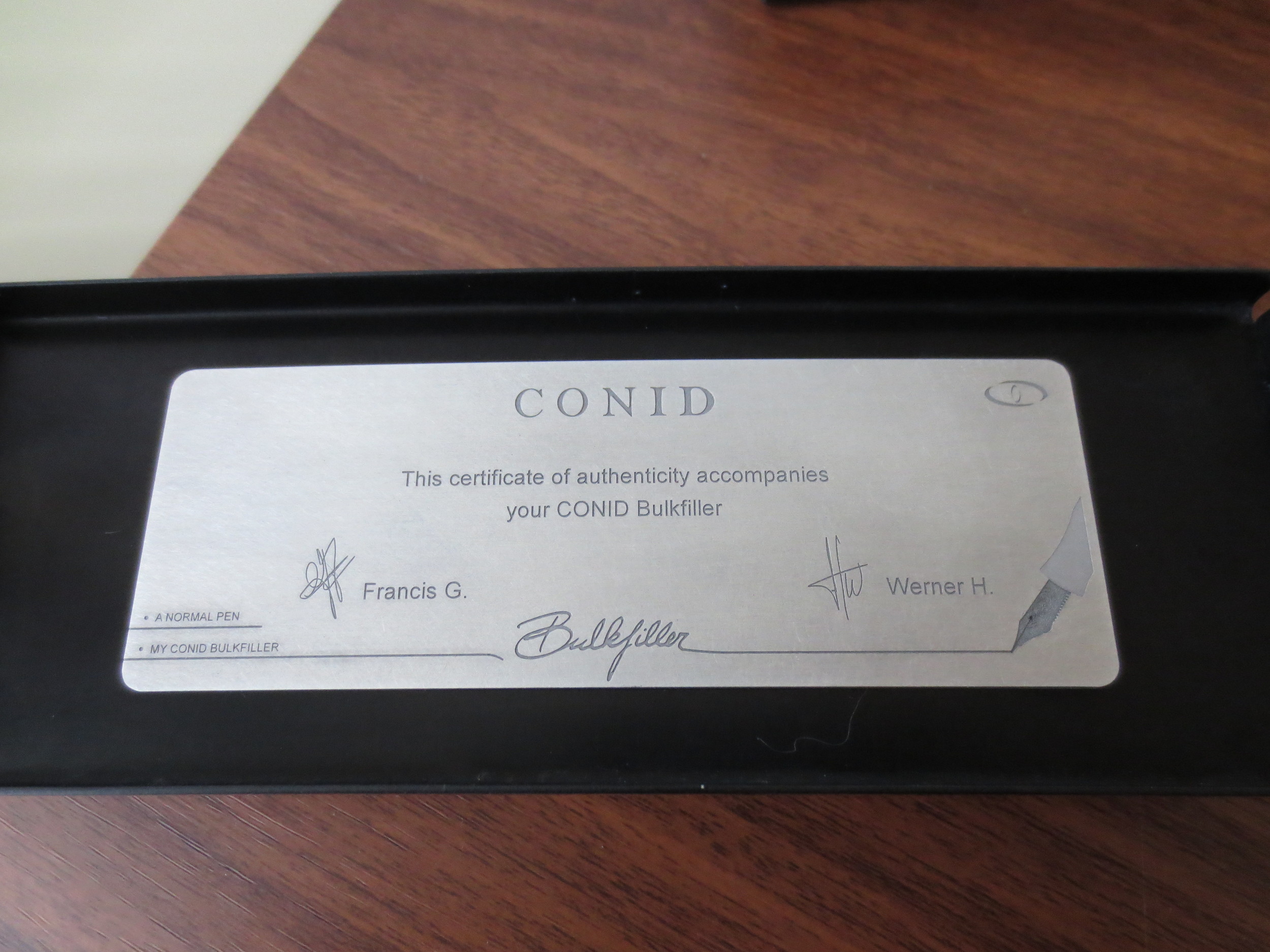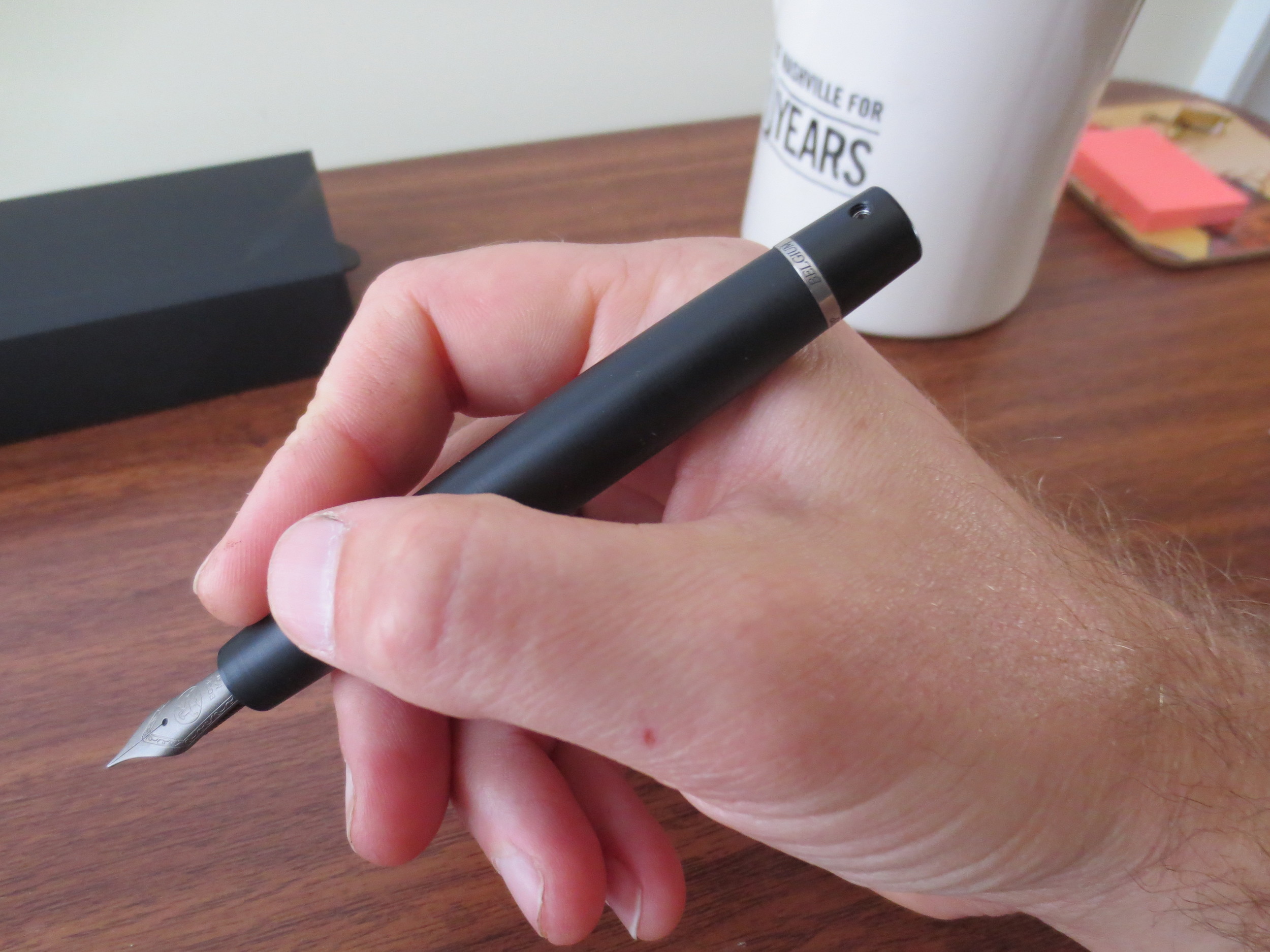Some of you may recall that back in April, I embarked on a “streamlining” of my pen and ink accumulation and sold off nearly a dozen pens, with the goal of buying three or four “custom” pens. While the Conid Bulkfiller is not a “custom pen” per se, because it’s not manufactured to each customer’s specifications, it is what I would call “small batch” (to borrow a whiskey term). Meaning, these pens are manufactured to order (i.e., the pen is not made until a customer’s order is placed), and some customization is possible. I opted for the Bulkfiller Minimalistica, a streamlined version manufactured from Delrin and trimmed with Titanium (including the nib).
History
Conid pens are built around the filling system, termed the “bulkfiller.” The name “bulkfiller” refers to the fact that most piston or plunger-filler pens do not fill to 100% capacity—the ink reservoir is never completely full. Francis Goossens (a noted pen repairman and collector who goes by Fountainbel on FPN) sought to correct what he considered a shortcoming, and the concept of the Bulkfiller was born.
The Filling System
It’s nearly impossible to describe the bulkfiller system without a visual aid. Watch this video first (courtesy of Conid and Francis Goossens via YouTube) and bear with me.
In short, the filling system acts like a syringe. While a typical plunger filler takes advantage of a vacuum in the barrel created when the user depresses the plunger past a certain point, ink enters the Bulkfiller on the upstroke (like a syringe), after which point the user disengages the plunger rod from the seal and slides it back into the barrel, leaving the seal at the top of the ink chamber. The pen holds a full 2ml of ink, and some of the larger models hold as much as 6ml.
The Minimalistica
Originally, Conid offered one model (the “Regular” Bulkfiller), but that has changed over the past few years. There are now 5 main options (Streamlined, Minimalistica, Regular, Kingsize, and Giraffe), and within certain of those primary offerings the customer can choose from different designs. The names of the models are fairly self explanatory (i.e., the “Giraffe” is a very long pen that holds 6ml of ink). I opted for the Minimalistica, a newer model that only comes in Matte Black Delrin and sports titanium trim. Since I purchased this pen for daily use, I chose the version with a clip.
Conid pens are manufactured entirely by CNC lathe in a factory outside of Antwerp, Belgium. Conid builds each pen to order, creating a lag time of 4-6 weeks between placing an order and receiving your pen. It’s worth the wait.
The Conid packaging is high-end. The pen arrives packed in foam in a metal box, with an engraved titanium plate certifying as to the authenticity. If you ordered a spare nib and/or the disassembly tool, those will also come packaged in the box.
The Build
People rave about the build on Conid pens. This is a pen addict’s pen, as it truly is “engineered for people who love writing.” The manufacturing tolerances are incredibly precise. Because Delrin seems to be a fairly “soft” material, and because it’s black, it shows some marks from the machining of the pen, but I can find no “flaws” in the pens finish. The titanium trim is especially well done, and the clip is a single solid piece of titanium!
The filling system on my pen works flawlessly, although it takes a few tries to understand how to engage/disengage the seal from the piston and to get the hang of filling it completely. Again, this pen is not for everyone. It’s the creation of a vintage pen repairman/collector who set out to perfect the fountain pen filling system by creating something that is a hybrid of the classic vintage fillers. I cannot emphasize how much ink this pen holds—it took me nearly three weeks to write it dry, and I write a lot and made a concerted effort to use this pen.
Fortunately, Conid provides helpful step-by-step instructions that ensure, eventually, that even the most mechanically challenged among us will be able to fill the pen.
There is one quirk. In order to make the pen safe for airplane usage and/or to prevent it from burping ink due to temperature or altitude fluctuations, the pen has two ink chambers: the larger chamber at the back, which holds the vast majority of the ink, and a smaller chamber up front, just behind the feed. The smaller chamber holds perhaps 2-3 pages worth of ink, and when it runs dry you have to unscrew the blind cap slightly (and sometimes give the pen a quick flick of the wrist) to allow ink from the back chamber to refill the smaller chamber and the feed. Several other vacuum-filling pens share this double-chambered feature—namely Viscontis that utilize the “Power Filling” system. Both the Pilot Custom 823 and the TWSBI Vac 700 require you to unscrew the blind cap to allow ink to flow through during prolonged writing sessions.
The pen is comfortable to use both posted and unposted. The cap is a slip-cap, which uses an O-ring for friction-fit, so the posting is not the most secure in the world, but I’ve never had it fall off. For some reason I tend to prefer this pen unposted, which is rare for me, but I think Conid nailed it on the length. See the gallery below for some size comparisons with the similarly sized Lamy 2000 and Delta Fusion 82. The Conid is a bit thicker.
The Nib
After trying Brad Dowdy’s and Thomas Hall’s Bulkfillers at the Atlanta Pen Show, I knew that I had to go with the titanium nib. The nib is manufactured by Bock (who, to my knowledge, manufactures most, if not all, of the titanium nibs for the fountain pen industry). I have had one other titanium nib in the past, a Stipula T-Flex, but I didn’t care for it and ended up swapping it out for a gold stub. I found the T-Flex too “flexy” for everyday writing, and too wet to use on standard office paper, which is the bulk of my fountain pen use. The standard Bock fine nib, however, is perfect for me. It’s one of the smoothest nibs I own, and there’s an ever-so-slight springiness to it that gives your writing good shading and visible line variation. In other words, it’s a good everyday writer without the more boring qualities of your typical stiff-as-a-nail steel nibs.
The No. 6 Titanium Bock Nib. Note that the brushed finish of the titanium nicely complements the Delrin. Most Bulkfillers come outfitted with a #6 nib. The Slimline sports a #5, and the Kingsize comes with a #8(!!?).
A writing sample with the fine titanium nib. Note the shading.
The Verdict
This is a great pen, and I don’t regret the money spent or the wait. I did choose the title "a pen geek's pen" deliberately--it’s not for everyone. The filling system is complicated and somewhat tricky to master, and if you’re a serial ink changer you may get bored with how long it takes to write the pen dry. But the manufacturing is superb, the nib is wonderful, and Conid’s customer service is outstanding (especially once they figured out how to refund the VAT for non-EU residents).
You can purchase the Bulkfiller directly from Conid on their website. Pricing is consistent with most custom pens, and ultimately depends on the options you select. The basic Bulkfiller Minimalistica with a steel nib will run about $315 (give or take a few dollars for the exchange rate). If you add a titanium nib and the proprietary tool for disassembly (allowing you to repair/clean the pen on your own without shipping it back to Antwerp), the price jumps to about $390 or so. It's expensive, but you are paying for quality machining, titanium trim, and a fairly rare material like Delrin that I understand to be somewhat difficult to work.
I purchased this pen with my own funds, and was not compensated monetarily for this review.













